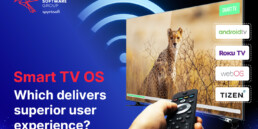Smart TVs have become so ubiquitous that, ironically, it’s become really hard to find a TV that’s not smart these days. It is estimated that smart TV accounted for 70% of all TVs in US households in 2018. But what is all the fuss about? What does the future hold for smart TVs? It’s hard to tell for sure, but one thing is certain: there is a lot going on.
The Main Drivers of Smart TV Growth
There are many drivers of Smart TV growth. Above all, contemporary TVs have processors and are becoming more and more snappy each year. They are also smart because technically they are not much different from a mobile phone or a tablet. This opens doors for a slew of new uses driving their further growth.
Streaming Apps and Binge Culture
Streaming services have completely re-defined the ways how, where, and when we experience television. Yes, with the advent of Netflix, HBO Go, Amazon Prime and Roku we’ve somewhat sacrificed the yesteryear’s thrill of watching live TV, and possibly lost the fun of co-experiencing it with thousands of other people. But the trade-off is so tantalizing we don’t even care anymore: streaming is the new TV, pampering us with its ample benefits.
Streaming services, a booming industry unto itself, are a serious driver for smart TVs. After all, what’s a better way of watching streaming media than on a big screen hanging right up on the wall in the living room, from the comfort of the cosy sofa opposite? Nothing beats this, and a TV without the rudimentary streaming media apps on board is close to obsolete.
Smart TV Remote Controls and Convenience
The modern TV remote controls come with buttons that would seem rather out of place only a decade ago: a voice controller (the mic button) and dedicated buttons for streaming services (see the image below: a Sony remote rocking buttons for both Google Play and Netflix). This allows the user to control the television with voice, or quickly start the streaming platform of choice with a single press of a button.

The addition of such a button may seem innocuous at a glance, but its presence alone could heavily influence how often a particular service is used by the owner of the TV. Such partnership potential between TV manufacturers and streaming media providers is practically infinite here (the first branded Netflix buttons started appearing on remotes in 2011).
Voice Assistants
With the growing presence of streaming services in TVs it was becoming more and more evident that the clunky traditional remotes could no longer cut the mustard for controlling smart TVs – especially for entering longer strings of words – e.g. when using a built-in streaming platform or web browser on a smart TV.
Voice assistants quickly came in tow. The assistants’ unassuming names – Siri, Bixby, Alexa, and Google Assistant (developed by Apple, Samsung, Amazon, and Google respectively) disguise rather advanced technology under the hood. The underlying goal of a smart assistant in a TV is to make the remote clunky, and ultimately obsolete – and, as the next step – bind all the other smart devices at home.
But there is more than meets the eye. Something that emerged as a way to ease the pain of navigating the advanced interfaces of Netflix, HBO, Roku and the like, may in fact be a part of a bigger agenda. While producers may not be sure how to monetize the tech now, by offering assistants by default in TVs, they can sneak their tech into people’s homes, and reserve a very favourable position when an opportunity to monetize it emerges.
The promise of seamless connectivity
The terms smart home and internet of things get tossed around more frequently today than ever before – and smart TV is an integral element of it.
Smart home is also an important driver for the adoption of smart TV’s. Many manufacturers envision a Smart TV as the hub, or the command center for all the “not-so-smart” internet-of-things devices (for example, the small IoT devices which lack a proper screen).
This is why a Smart TV will soon be seen as the most important piece of the smart home puzzle in every household. For once, it determines which voice assistant will be the one the family is most familiar with, and become the dominating one. This, in turn, will very likely determine which smart home ecosystem the family will take a dive in: Apple’s, Google’s, Amazon’s or Samsung’s.
The leading operating systems in Smart TV
In terms of operating systems, the smart TV landscape seems even more fragmented than in personal computers today. Because smart TVs are only in their nascent phase, we’re witnessing a scramble between the big tech brands for the best seats on the smart TV bandwagon.
Google is leading the charge by a large margin:
For an average Joe, the operating system in the TV set may be of little to no importance – as long as it works and runs all the necessary apps, of course. However, from the producers’ point of view, it is a part of the business tug-of-war – the operating system in a smart TV heavily influences which voice assistant the device will come on with.
For example: because Tizen is an operating system developed and used primarily by Samsung, any Tizen-based device is likely to have Bixby (Samsung’s voice assistant) on board. Sony has gone all the way for Android TV and Google’s Voice Assistant, completely giving up the thought of coming up with their own.
Interestingly, recent reports indicate that the new line-up of Samsung smart TVs might support Google Assistant. This comes on the heels of a similar move, when in 2018 LG smart TVs started shipping with both Google Assistant and Alexa. Decisions like these show that manufacturers, in all the race for smart TV dominance, don’t want to alienate users, and prioritize compatibility after all.
If you find this article valuable, you can share it on social media →
Read more about the Smart TV applications!
February 20, 2024
What is Titan OS and what do we know about it so far?
Explore what distinguishes Titan OS, a new smart TV operating system. Discover its unique features before giving it a try yourself.
January 30, 2024
Smart TV operating systems: which offers the best user experience?
Discover the best Smart TV operating systems in our expert analysis. Compare top platforms, focusing on user experience.
November 23, 2023
7 Smart TV Features for a Seamless Streaming Experience
Discover emerging opportunities in the Smart TV market. Find out how service providers can leverage enhanced Smart TV features to stay ahead.
Are you looking for a partner to build an application on Smart TV?
Leave your email and a short description about your project. We would gladly discuss different cooperation possibilities!



 Source
Source

